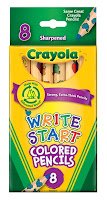We started small. Crayons and colored pencils preceded markers and fingerpaint...and that experience actually led to a discovery I should have known from my early childhood education. What follows are the experiences myself and other "testers" had with products included in our art kits for 12-24 month toddlers (or older children in the same developmental place with fine and gross motor skills). Admittedly, I did not go out and buy every product on the market in order to test them against other brands (and no, I have no affiliation with Crayola...at least, not yet :) ), I simply present our own experiences here:
Crayons: Crayola Large Washable Crayons
These are rated for 4 years and up. I'm not sure why there's such a big difference in age range recommendation for these versus the triangular crayons. We chose the 16 count so that we could explore more colors and a few different shades of the basics. The crayons are designed to wash off of walls with warm water and a sponge (a high selling point for me). The large diameter is great for beginning scribblers who hold it in their fists and the larger tip covers larger spaces faster. This is not for detail work, which is great, because Little Scribblers are just starting to figure out those gross motor skills still. Because much of our work was done at her high chair tray, we had no problem with the crayons rolling, but when we moved to the table, we tried out the triangle crayons.
Crayons: Crayola Washable Triangluar Crayons
Rated for 24 mos. and up. The 16 count boxes include: 2 shades of red, 1 pink, 3 orange, 1 yellow, 2 green, 2 blue, 2 purple, 1 brown, 1 black, 1 white, and 0 shades of grey. ;) The anti-roll is definitely a bonus feature of this set: no more chasing crayons across tables or floors when art time moves away from the high chair. Another benefit: they promote correct writing grip (also called the tripod grip) that Little Scribblers begin to develop as they get close to 24 months. We wanted to compare them to the Melissa & Doug product that is similar, but I could find no absolute information about the washability of the product and the colors were more limited. A significant drawback here: I had to take one box back to the store right from the start because all of the tips were broken off and one parent in the test group had similar issues with breakability during art time. The Crayola web site has similar complaints, so some of that may be production, and some of it may be how Little Scribblers use crayons at first...not as intended. For now, we will be using these crayons because they are such a benefit as grip is changing from a fistful to a tripod grip naturally throughout this stage of development.
*A note on crayons: there is a big difference between the washability of those marked as "washable" and those that aren't. We have definitely seen the difference when we used a set that was not marked washable that was given to us as a gift. As Little Scribblers get closer to three years of age, their scribbling is more intentional and stays on the paper put in front of them more often than not. Save crayons that are not washable for later in the development of intentional scribbling.
Colored Pencils: Crayola Write Start Colored Pencils
There is no age recommendation on the box, but Crayola's web site sets it at 6+ years. The one drawback is that they are not necessarily washable, but I love them for toddlers anyway. They are extra-thick, making them pretty durable. Maybe it's my imagination, but the tips also seem to be thicker, too. They haven't broken off in over two years of use and (unlike the crayons) have only sustained minimal tooth damage because the "soft" coloring area is really a pretty small target for incoming teeth. I loved using these when tired of the "Not in your mouth!" battle. The pencils are also hexagonally shaped, so they are easy to hold in a fist or with a more traditional grip, and they share the anti-roll benefit of the triangular crayons. For me, sustainability is important for wood and paper products and according to the packaging these are made from reforested wood and don't use rain forest woods or endangered species. The design on the outside is pretty simple (bare wood with a figure in a certain color) and reinforces color concepts by connecting it to an item typically of that color such as a red apple or green frog.
So why no markers or paint here? Well, those just go in a messier category in the first place, but here's the discovery (or maybe recollection from my preservice teacher training): offering a crayon or a colored pencil instead of a marker helps to develop the finger, hand, and arm muscles needed later for writing. Technically, they are developing pre-writing skills when they have to push down on the paper to create color. So give your kiddo an extra-strong crayon or colored pencil and build some muscles while creating beauty!




No comments:
Post a Comment